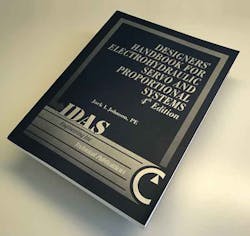Handbook Serves Electrohydraulic System Designers
The fourth edition of the Designers’ Handbook for Electrohydraulic Servo and Proportional Systems contains even more useful information than its predecessor, the highly successful third edition, which has become the de facto Bible for electrohydraulics technology. Now you can learn even more about electrohydraulic systems and their design, including:
- how to calculate and control pressure losses in plumbing, subplates, and manifolds,
- how to analyze and control a variety of mechanical loads, including conveyors and belts and triangulated loads,
- valve dynamic properties and how to include them in your system,
- electronics, especially transducers and signal conditioning, and
- mobile equipment electrical systems, including batteries and charging systems.
There is no limit as to how electrohydraulics is going to improve our industry, so order your copy to secure your career in this dynamic technology. And if certification in electrohydraulics is your goal, the fourth edition of the Designers’ Handbook is essential to your preparation. The textbook contains nearly 800 pages and sells for $159. To order, click here, browse through the titles, fill-out the PDF order form, and e-mail, fax, or mail the form to us.


